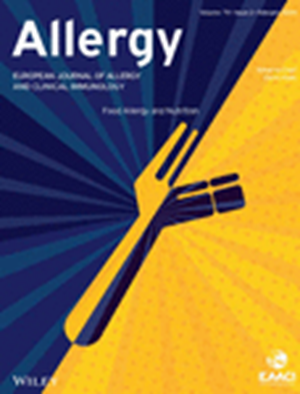具有IgE交联能力的花生蛋白在人乳中的分泌。
IF 12
1区 医学
Q1 ALLERGY
引用次数: 0
摘要
背景:母乳为婴儿提供了接触膳食抗原的最早途径之一。需要更好地了解母乳中母体膳食蛋白质(HM)的水平和功能及其对婴儿食物过敏的影响。目的测定孕妇膳食蛋白质的含量和生物活性,并探讨其存在的相关因素。方法在食用预先规定量的花生、鸡蛋和牛奶蛋白之前和之后,收集有或没有FA的婴儿母亲的shm样本。采用酶联免疫吸附法(ELISA)检测花生Ara h2、鸡蛋卵白蛋白和牛β-乳球蛋白。通过嗜碱性细胞活化试验(BAT)评价Ara h2的ige交联能力。采用乳果糖/甘露醇试验测定孕妇肠道通透性。结果共纳入39名母亲,其中69%的母亲在HM中可检测到Ara h 2。食物过敏原的分泌在不同的母亲和不同的过敏原之间是可变的,但与肠道通透性无关。特应性母乳中Ara h2的峰值浓度(中位数为246 pg/mL,范围为2.0-1634)高于非特应性母乳(中位数为0 pg/mL,范围为0-135,p = 0.017)。在BAT反应性最强的样品中,BAT反应性与Ara h2水平呈显著相关(R = 0.72, p = 2 × 10-8)。针对不同表位的多个单克隆抗体以相似的水平检测Ara h2。结论ara h2在HM中以完整蛋白或具有ige交联能力的重要部分分泌,在特应性母亲中水平较高。花生HM水平与其他饲粮蛋白质缺乏相关性,提示饲粮蛋白质向HM分泌具有抗原特异性。本文章由计算机程序翻译,如有差异,请以英文原文为准。
Secretion of Peanut Protein With IgE Crosslinking Capacity in Human Milk.
BACKGROUND
Human milk provides an infant one of the first routes of exposure to dietary antigens. A better understanding of the levels and functional capacity of maternal dietary proteins in human milk (HM) and their impact on infant food allergy (FA) is needed.
OBJECTIVE
To measure the quantity and biologic activity of maternal dietary proteins in HM and determine factors associated with their presence.
METHODS
HM samples from mothers of infants with or without FA were collected before and serially after consumption of a meal with prespecified amounts of peanut, egg, and cow's milk protein. Ara h 2 from peanut, egg ovalbumin, and bovine β-lactoglobulin in HM was detected using ELISA. IgE-crosslinking capacity of Ara h 2 was assessed by the basophil activation test (BAT). Maternal intestinal permeability was measured with the lactulose/mannitol test.
RESULTS
Thirty-nine mothers were included and 69% had measurable Ara h 2 in HM. Secretion of food allergens was variable between different mothers and across allergens, but did not correlate with intestinal permeability. Atopic mothers' milk had a higher peak Ara h 2 concentration (median 246 pg/mL, range 2.0-1634) than nonatopic mothers (median 0 pg/mL, range 0-135, p = 0.017). In samples with the most BAT reactivity, there was a significant correlation between BAT reactivity and Ara h 2 level (R = 0.72, p = 2 × 10-8). Multiple monoclonal antibodies directed at different epitopes detected Ara h 2 at similar levels.
CONCLUSION
Ara h 2 is secreted in HM as intact protein or significant parts of it that are capable of IgE-crosslinking, found in higher levels in atopic mothers. HM levels of peanut lack correlation with other dietary proteins, which suggests antigen specificity of the secretion of dietary protein into HM.
求助全文
通过发布文献求助,成功后即可免费获取论文全文。
去求助
来源期刊

Allergy
医学-过敏
CiteScore
26.10
自引率
9.70%
发文量
393
审稿时长
2 months
期刊介绍:
Allergy is an international and multidisciplinary journal that aims to advance, impact, and communicate all aspects of the discipline of Allergy/Immunology. It publishes original articles, reviews, position papers, guidelines, editorials, news and commentaries, letters to the editors, and correspondences. The journal accepts articles based on their scientific merit and quality.
Allergy seeks to maintain contact between basic and clinical Allergy/Immunology and encourages contributions from contributors and readers from all countries. In addition to its publication, Allergy also provides abstracting and indexing information. Some of the databases that include Allergy abstracts are Abstracts on Hygiene & Communicable Disease, Academic Search Alumni Edition, AgBiotech News & Information, AGRICOLA Database, Biological Abstracts, PubMed Dietary Supplement Subset, and Global Health, among others.
 求助内容:
求助内容: 应助结果提醒方式:
应助结果提醒方式:


